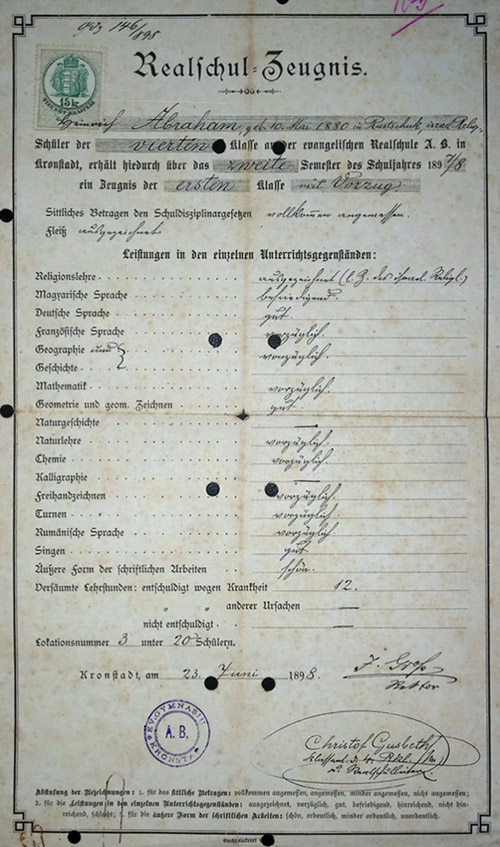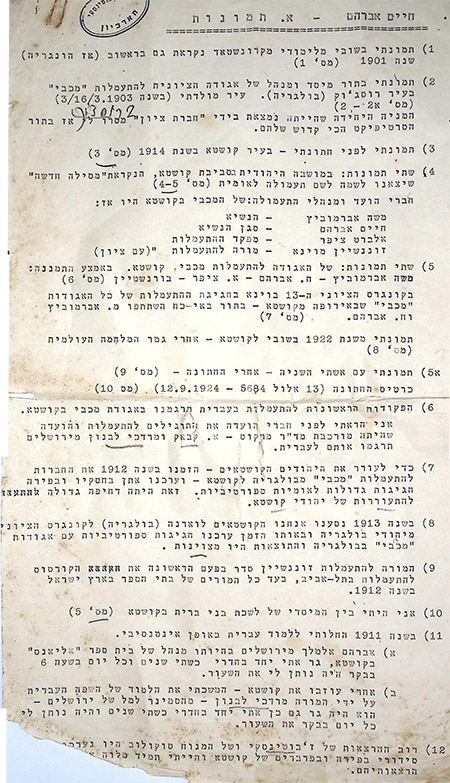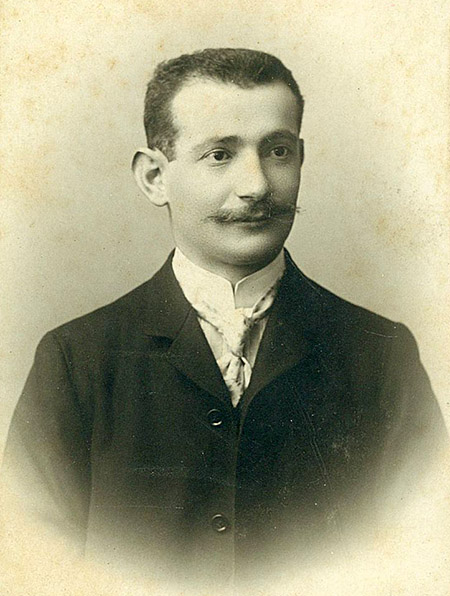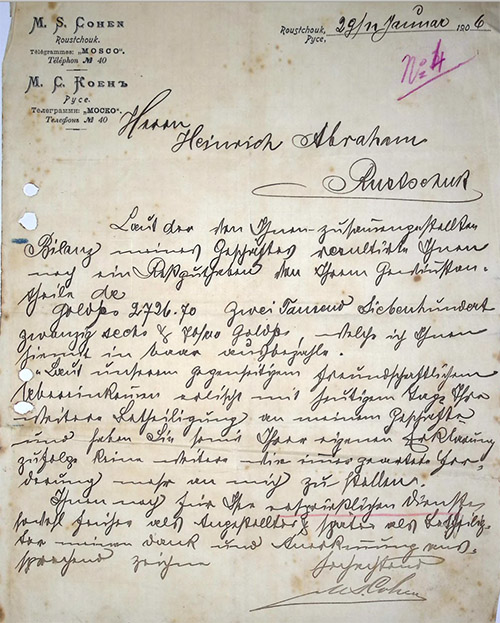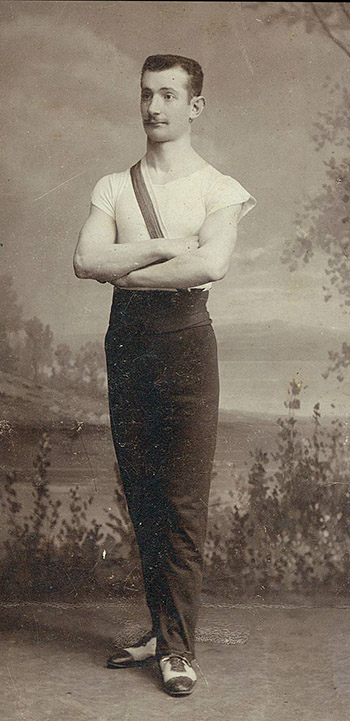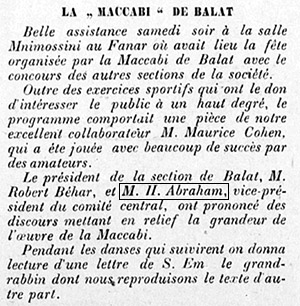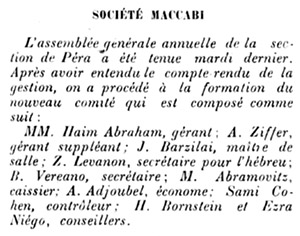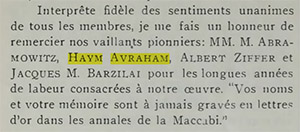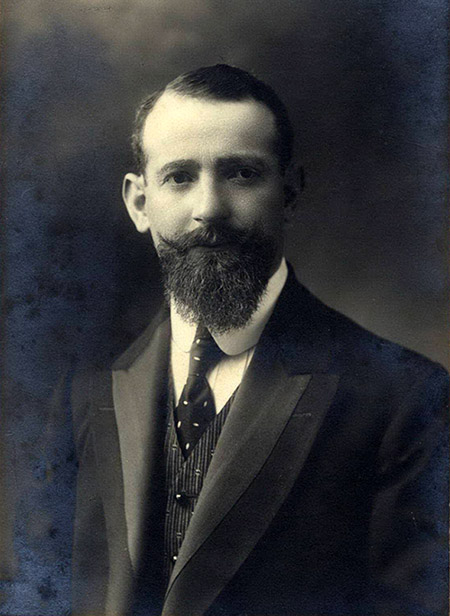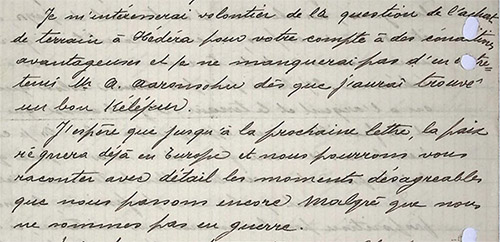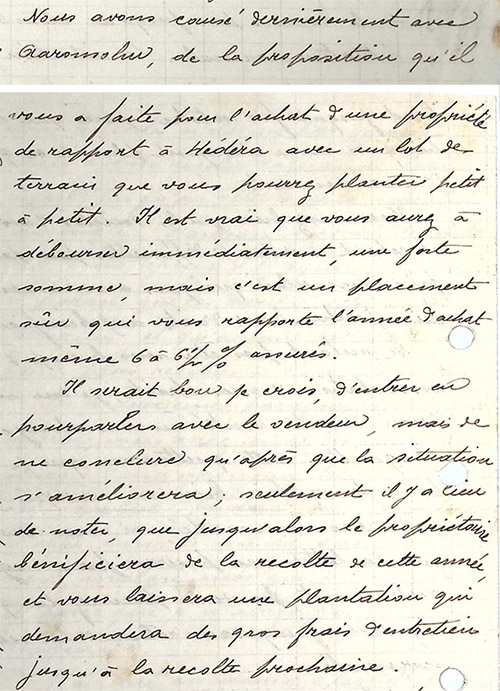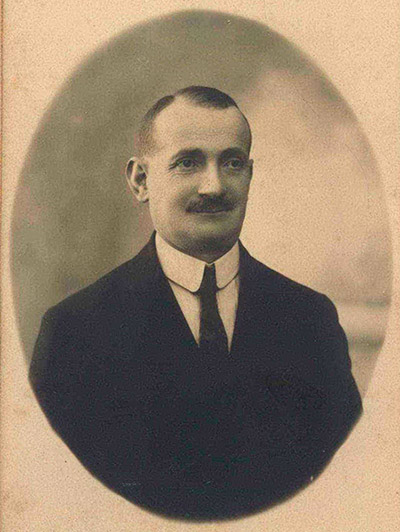Haim Abraham
Spelling variations: Haim, Chaim, Haym Avraham
Alternate names: Henri, Heinrich Abraham
If Haim Abraham's name is remembered today, it is as the husband of Sarah Aaronsohn, the NILI heroine. There is more to his story however, as I have found after years of research, and many of the so-called "facts" and unflattering descriptions captured in books about NILI are contradicted by the actual facts. Here is his story.
Early Life of Haim Abraham
Haim Abraham was born on May 22, 1879 (May 10 according to the Julian calendar in use at the time of his birth), the son of Mamo Abraham, a merchant and Lea, née Jakob, in Rustchuk (Ruse), Bulgaria.
He had three younger brothers: Moshe (Moritz), Isak and Mony.

List of Abraham family births drawn by the Sepharadic Congregation of Rustchuk, written in Ladino, 1901.
Haim is the first entry.
Source: Jabotinsky Archives
Rustchuk, the fifth largest city in Bulgaria, is located on the right bank of the Danube river, across from the Romanian border. Just 50 miles (80 kms) from Romania's capital Bucharest, and 200 miles (300 kms) from Bulgaria's capital Sofia. It was at the time of Haim's birth a prosperous merchant town, home to a well-to-do Jewish community representing about 10% of the city's total population.
Previously in the Ottoman Empire, it became part of modern Bulgaria in 1878. It was a cosmopolitan city with a multiethnic population, comprised of Bulgarians, Turks, Jews, Armenians, Germans, Greeks, Romanians, Russians, Serbs, Croats, Hungarians, Italians, and others.
Haim's parents died when he was still a young boy. His mother Lea died from tuberculosis in February 1892 when he was twelve years old. Twenty-one months later, his father Mamo passed away from the same disease, and Haim became a double orphan at the age of fourteen.
After the death of his parents, Haim and his three younger brothers were raised by their maternal grandparents, Salomon (Mony) Jakob and Rebecca and, occasionally, by their aunts. Very little is known about his grandparents, but they appear to have been well-to-do merchants.
The earliest photo of Haim is a group portrait of the four Abraham brothers, taken in 1896, two years after their parents' death.
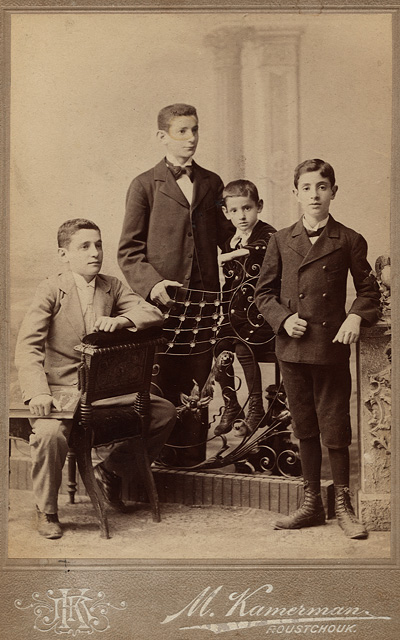
Haim, Moritz, Isak and Mony Abraham, Rustchuk, 1896.
(Collection of the author)
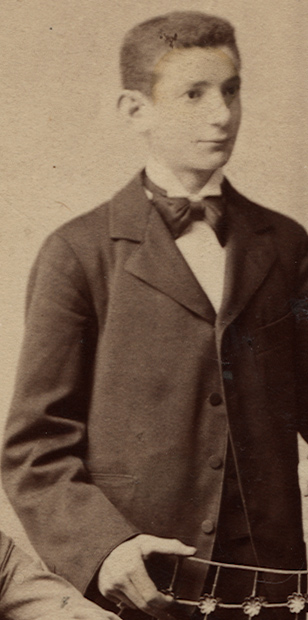
Haim Abraham, age 17, Rustchuk, 1896.
(Collection of the author)
Haim's family belonged to the Sepharad community, presumably descendants of Jews expelled from Spain in the 15th century. Although the term "Sepharad" conjures images of "Oriental" Jews, this photo shows that the Abraham brothers, like most of the Rustchuk Jewish community, were actually westernized.
Indeed, the Jewish community in Bulgaria was unique. Neither completely assimilated like western Jews "of the Mosaic faith" found in France, Germany, or England; nor ghettoized and attached to the scriptures and the past like the eastern communities, they were by the end of the 19th century westernized, while still retaining a strong Jewish identity.
Belying their supposed "Oriental" origin, this photo shows the Abraham brothers in western attires. Despite being orphans, their clothes also suggest that they belonged to the middle-class world of Jewish merchants that thrived at the end of the century in Rustchuk.
Education
Haim received his early education in the primary boys' school run by The Alliance Israélite Universelle in Rustchuk. (This is aluded to by Haim in a speech he will give in 1910 to denounce the assimilationist aims of the Alliance Israelite Universelle, as quoted in the November 4, 1910 issue of l'Aurore.)
The curriculum in AIU primary schools (grades 2 to 7) included French (the primary language), Arithmetic, Geography, History, Science, Physical Exercise, Handicrafts, and Singing; In addition, Hebrew, and basic religious instruction - limited to no more than 2 hours a week - were taught.
According to Saul Mezan's 1925 "Les Juifs espagnols en Bulgarie", Alliance schools were to be credited for having successfully introduced modern French education to "uncultured Sephardicism in decay", and had an enormously positive influence on the Jewish masses. He complained, however, that "no subject was more neglected than Hebrew", and that it was taught as the "holy" but dead language, as opposed to "Ivrit" - modern Hebrew.
According to Sarah Cohen Eldar, Haim then attended and graduated from the highly regarded Rustchuk Gymnasium. Required subjects in the curriculum included Bulgarian, German, French, Russian, History, Geography, Arithmetic, Geometry, Algebra, Physics, Chemistry, Natural Science, Psychology, Ethics, Calligraphy and Gymnastics.

Rustchuk, Gymnasium for boys
According to Sarah Cohen Eldar, Haim was then sent by his grandparents to study business in Germany. There, he started to go by the name of "Heinrich", the name he would continue to use until at least 1906.
Two documents from the Jabotinsky Archives provide evidence that he actually attended the Kronstadt Evangelical Realschule in Brașov.
Brașov (known in German as Kronstadt), about 280kms (180 miles) north of Rustchuk, was at the time in Hungary (then part of the Austro-Hungarian Empire), now in Romania. Historically at the intersection of trade routes linking the Ottoman Empire and Western Europe, it was home to a mix of German, Romanian, Bulgarian and Hungarian populations, including a small Jewish community.
The Kronstadt Realschule (high-school) had an excellent reputation and attracted students from Transylvania, Romania and Hungary.
The following school report, preserved in the Jabotinsky archives, shows that Haim excelled in his studies. During the second semester of 1898, aged nineteen, he received top grades ("excellent") in 9 out of 13 classes, and was ranked third out of twenty students in his fourth-grade class. Of note is the fact that Haim excelled not only in academic studies, but also in gymnastics, which would play an important role later in his life.
Heinrich Abraham, born May 10, 1880* in Rustchuk, of Jewish religion,
student in the fourth-grade in the evangelical high-school in Kronstadt,
is awarded a first class ribbon [? ("Beugnis")] with merit for the second semester of the school year 1897/1898.Religious Education: Excellent
Hungarian: Satisfactory
German: Good
French: Excellent
Geography: Excellent
History: “ “
Mathematics: Excellent
Geometry and Geometric Drawing: Good
Science: Excellent
Chemistry: Excellent
Free hand Drawing: Excellent
Gymnastics: Excellent
Romanian: Excellent
Singing: Good
Note that Haim's year of birth was 1879, according to various transcripts from the Rustchuk community, so 1880 may be a clerical error, unless it was an intentional "error" on the part of Haim's grandparents, possibly to fulfill a certain age requirement to be enrolled in the school.
While nothing is known about Haim's grandparents, the fact that they sent him to Kronstadt for his studies indicates that they had sufficient means to afford doing so, most likely doing the same for his three brothers. In addition, since the school was associated with the Evangelical Church, it can be assumed that they were open to western culture and modernity, and saw the value of secular higher education - unlike the Eastern Orthodox Jews, or the Orientalal community. In this, they mirrored the Jewish middle-class of Rustchuk.
Haim probably spoke at least half a dozen languages. He was fluent in at least four: Ladino, French, German, and Hebrew, and had at least some knowledge of Romanian and Hungarian. In addition, he most likely knew Bulgarian, and might have have been able to understand some Turkish.
His native tongue was Ladino, the Judeo-Spanish tongue of the Sepharad community in Rustchuk. Later as an adult in Constantinople, Haim is known to have written and given speeches in that language, confirming his knowledge of what was called "Spanish" within the Jewish community.
He then learned French as a young child while attending the elementary school run by L'Alliance Israelite Universelle, as this was the language used for most of the curriculum there.
By the time he started attending the Kronstadt Realschule, he needed to know German, as his was the language used for all the classes there. Not only would German be required to run his business later, it would also be proved useful as he spent part of war years in Germany. German also seems to have become part of his identiy at an early age: he went by the name of Heinrich Abraham for many years.
While at the Rustchuk high-school, he probably had to learn Bulgarian and Russian, both part of the required curriculum in the late 1800's in Bulgaria.
Next, while in the Kronstadt Realschule, Haim also learned Romanian and Hungarian, as evidenced by his school report.
A few years later, starting in 1911, he would study modern Hebrew for two years at the age of twenty-one and started giving speeches in that language.
Surviving letters exchanged between Haim and the Aaronsohn family illustrate his command of these languages: Aaron Aaronsohn wrote to Haim in Hebrew, Haim responded in German, while Sarah Aaronsohn wrote to him in French.
It is important to note that Haim's knowledge of so many languages was not exceptional at the time in the Jewish community of Rustschuk, but instead the norm. Elias Canetti, the Nobel Prize author born in Rustchuk in 1905, wrote:
"Seven to eight languages were spoken in our town [Rustchuk]. Everyone understood somewhat all the languages used; It was only the young country girls who just knew Bulgarian, so they were said to be stupid. Everyone counted how many languages they knew, it was most important to master a large number [...]"
An Aside Concerning Archival Material
Two folders of documents belonging to Haim are in the Jabotinsky Archives in Israel. These include photographs along with an annotated list describing the photos, together with several personal and business-related documents, such as his school report, cash receipts, birth certificates and so on. How did these documents end up in this archive? Did Haim donate these documents to the Jabotinsky Institute? Or did he give them to someone who then gifted them? Or were these donated by his second wife Miriam after his death?
Similarly, a number of letters written by Aron and Sarah Aaronsohn to Haim have survived, and I've always wondered how they had surfaced, since Haim had no descendants. It is thus possible that these letters were donated, either by Haim or his wife, along with the photos and his miscellaneous documents.
Since Haim never had children, he may have wanted to ensure something about his life, along with artefacts related to Sarah Aaronsohn, would be preserved.
Related to this trove of documents, the choice of the Jabotinsky Institute, if it was indeed Haim's decision, is interesting, as it could provide insights on his political leanings, unless of course they were the only group interested in preserving the Nili story then.
Return to Rustchuk and Early Career
According to Haim's notes kept the the Jabotinsky Archives, he returned to Rustchuk after completing his studies in Kronstadt (Brasov) in 1901. He was then twenty-two years old. There he started his business career at a relatively young age.
A business separation letter dating from January 1906 provides some insights on Haim's early career and his ambitious character. After first learning business practices as an employee of a M.S. Cohen, he had risen to become his partner, then decided to strike on his own at the age of 26.
Mr Heinrich Abraham
Rustschuck, 29 January 1906
According to the balance sheet of my business that you compiled, you still have a remaining balance of your share of 2 726.70 - two thousand seven hundred twenty six & 70/100 Goldfas (Goldfranken or Goldfrancs), which I hereby pay you in cash.
According to our mutual amicable agreement, your further participation in my business ends as of today, and, according to your own declaration, you therefore no longer have any further claims of any kind with me.
I would like to express my gratitude and appreciation to you for your valuable services both earlier as an employee and later as an affiliate (partner?).
Sincerely,
M.S. Cohen
Maccabi and Zionist Activities in Rustchuk
After his return to Rushchuk, Haim began his lifelong involvement with Zionist organisations and was one of the founding members of the Rustchuk Maccabi, the Jewish Gymnastics and Music Association.
According to "Maccabi Bulgaria" (p44):
"On February 10th 1902 a group of youngsters founded the Maccabi Association in Ruse under the name "Jewish Association for Gymnastics and Music - Maccabi". In 1905, after a fierce internal struggle, the Association defined itself as a Zionist organization."
"Thanks to the active help of the Jewish community, which wholeheartedly supported the first organisation of its youths, thanks to the effective support of the World Zionist Organisation, to the enthusiasm of the youths' management and to the talent of its leader, Heinrich Abraham*, Maccabi expanded its ranks from 42 to 100 members within a year. During this year, the association held ten performances, designed its members' uniforms and inaugurated its flag."
*Note: Haim called himself "Heinrich" in Rustchuk after his return from Germany.
In July 1902, Haim received one share of the Jewish Colonial Trust from the Zionist Association in Rustchuk in recognition of his work with the Rustchuk Maccabi Association.
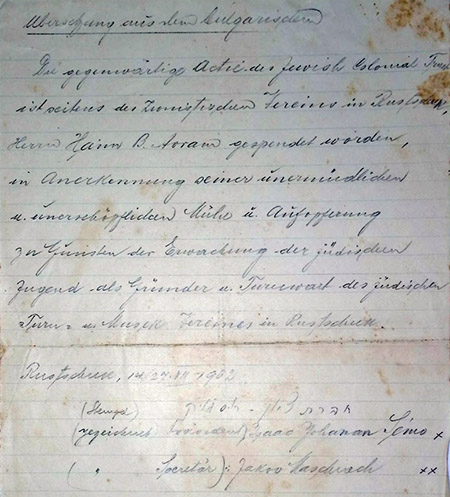
Gift of a share of the Jewish Colonial Trust to Haim, 1902
Translation from the Bulgarian
The present share of the Jewish Colonial Trust has been donated by the Zionist Association in Rustchuk to Mr. Haim B. Abraham in recognition of his tireless and never-ending effort and sacrifice for the awakening of the Jewish youth as founder and gymnast supervisor of the Jewish Gymnastics and Music Association in Rustschuk.
Rustschuk, 14/27 July 1902.
(stamp:) Rustchuk Zionist Association
President: Isaac Johanan Semo
Secretary: Yakov Maschiach
In December 1903, several Maccabi clubs from Bulgaria met in Sofia for their first national conference which Haim attended as the representant for the Rustchuk club.
David Rimon:
"On December 25, 1903, the first national conference was held in Sofia, attended by Maccabi groups from Ruse, Plovdiv, Pazardzhik and Sofia. The Zionist Organization in Bulgaria sent a special representative to this conference to congratulate the Maccabi convention and to participate in it on its behalf."
"The conference was limited to preparing the ground for the founding of the association, and elected a central committee whose task was to determine the regulations of the national association, its name, etc. The following were elected to the committee: Leon Cohen (President), Yaakov Tager, Emanuel Nasimoff, Alexander Radbil (today the four of them are in Tel Aviv) and Rahamim Baruch. The management of the technical work was handed over to the branch in Ruse under the presidency of Haim Avraham (today he is in Haifa)."
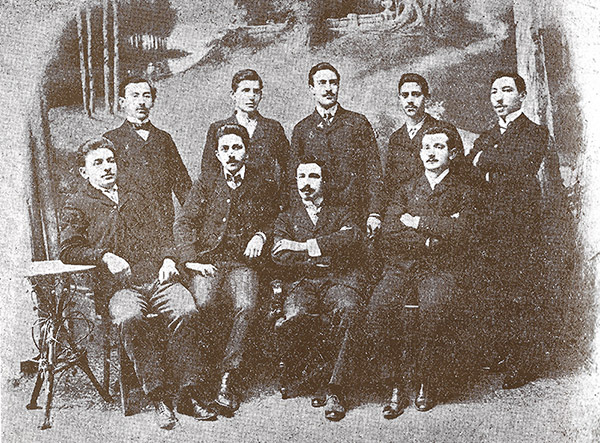
The first national conference of Maccabi associations in Bulgaria (December 25-27, 1903).
Seated from right to left: Haim Abraham, Shabbat Borochov, David Kalev, Aharon Manoach. Standing: Rachamim Borochov, Molcho, Emanuel Nissimoff, Adv. Moshaiv, Aharon Danon.
Haim was about 24 years old at the time this photo was taken.
(Photo source: "Maccabi Bulgaria", also in "HaMaccabi Be'Artzot HaBalkan" with caption above.)
The Bulgarian Maccabi was the most Zionist-leaning of the Jewish Sports organizations at the time, and, in 1903, the year this photograph was taken, gymnasts from Bulgaria performed for the delegates of the Sixth Zionist Congress. It is quite likely that Haim attended the 1903 Congress with the Maccabi group. Sarah Cohen Eldar recollected that Haim attended several Congresses, although I have only found evidence of him attending the 1913 Congress.
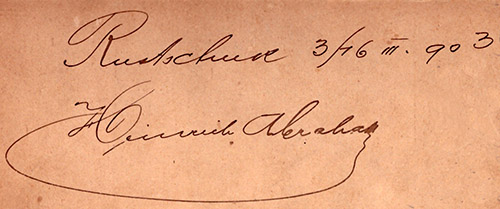
Signature on the back: "Heinrich Abraham", as Haim called himself then. March 16, 1903.
Photo collection Iris Eldar Nir
Constantinople
In the Summer of 1908, at the age of 29, Haim left Rustchuk and came to Constantinople with his younger brother, Moritz.
The two brothers formed an import/export company called "Abraham Frères" which sold a variety of small manufactured products from Germany and neighboring countries, such as razor blades, iron padlocks, shoe polish and paper envelopes all over the Levant.
The earliest known mentions of the company date from 1908, altough their business may have predated this date and their arrival in Constantinople.
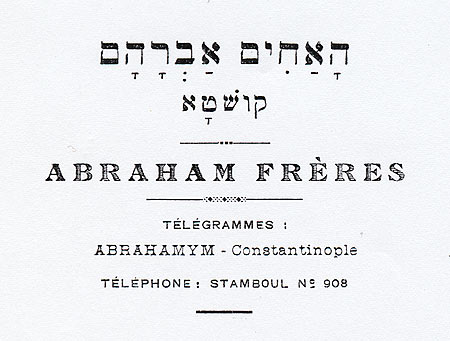
Abraham Freres, letterhead, 1918.
(Collection of the author)
The business was successful, and Haim and Moritz were variously described as "prosperous merchants" or "well-to-do importers".
The import business required frequent travel to Germany and to central European countries, often taking Haim away from Constantinople for a month at a time.
With the Maccabi in Constantinople.
Soon after his arrival in Constantinople, Haim joined Maccabi, the Jewish Gymnastics Association.
The Maccabi Sports Organization of Constantinople (originally known as the "Israelitischer Turnverein Konstantinopel" - the Israelite Gymnastics Association of Constantinople) had been founded in 1895 by Jews of German and Austrian extraction who had been rejected from participating in other sport clubs because of their Jewish origin. It was the first Jewish sports club.
In "HaMaccabi Be'Artzot HaBalkan" (The Maccabi in Balkan States), p96, David Rimon wrote:
"A few weeks after the Young Turks revolution [July 1908], the brothers Haim Abraham and Moritz Abraham, members of Maccabi Rustchuk in Bulgaria, came to Constantinople. The brothers immediately went to work and devoted much of their time and energy to the development of the association."
"At the same time, Dr. Israel Auerbach, the representative in Turkey of the "Hilfsverein der Deutschen Juden" and a reporter of the official Zionist weekly "Die Welt" also arrived in Constantinople. Dr Auerbach, who prior to his arrival in Constantinople had been the president of "Bar Kochba" in Berlin (Jüdischer Turnverein Bar Kochba Berlin) and the president of the Association of Jewish Gymnastics Societies in Germany, as well as the editor of the journal "Jüdische Turnzeitung", joined the management of the Maccabi association in Constantinople and contributed his talent and extensive experience in both the organisational and technical fields".
[...] "Under the influence of a few Zionists who were in Constantinople at that time, the Jews launched an internal propaganda for nationalism and Zionism. Among these Zionist influencers were Dr. David Marcus, rabbi of the Ashkenazi community, and Dr. Victor Jacobson, a representative of the Zionist General Council in Constantinople and director of the Anglo-Levantine Bank. [...] A few months after the [July 1908 Young Turk] Revolution, Ze'ev Jabotinsky came to Constantinople. The influence of these Zionist leaders led by Jabotinsky, as well as the two Maccabis who came from Bulgaria [Haim ("Heinrich") and Moritz Abraham], caused a complete change in the character of the "Israeli Gymnastics Association", which in September 1908 already enacted a "national" [read "Zionist"] constitution."

Leadership of Maccabi, presumably in the courtyard of the Goldschmidt school in Pera, the main location of the Jewish Gymnastics Club in Constantinople. 1908.
Middle row, center is Haim Abraham; front row, lying on the left is his brother Moritz Abraham; back row center, sitting on pommel horse is Moritz Abramovitz, chairman of the association.
(Collection of the author)
This photo is on the front of a postcard addressed to "Herr Abraham, Isr. Turnverein, Constantinople" and was mailed on July 24, 1908 from Munich.
According to Roman Sinkovsky's "Jewish German gymnastics system in Turkey until 1918":
"In 1908 the Israelitischer Turnverein changed its name to the national-Jewish "Maccabi". This renaming act followed naturally after the general assembly on May 25th 1908 when the club announced, for the very first time publicly, its national-Jewish conviction. This proposal originated by H. Abraham who declared that he was willing to hold his position [vice chairman] only in a national-Jewish turnverein."
Note that this excerpt indicates Haim in Constantinople in the Spring of 1908, a few months before the Young Turks revolution.

Gymnasts of the Maccabi section of the PERA district in Constantinople, ca. 1908.
Second row, center: Haim Abraham with arms crossed and dark suit and Moritz Abramovitz
Source: Haim Abraham folder in Jabotinsky Archives.
A copy of this photo from Albert Zipper's collection is also kept in archive.maccabi.org, where it is dated as from 1906. This is most likely incorrect, as the organization renamed itself "Maccabi" in 1908.
Sarah Cohen Eldar recalled:
"Haim, during this chapter of his life, invented Hebrew terms for gymnastics commands."
Although not naming Haim, the following confirms the creation of Hebrew terms. Sinkovsky:
"Starting in May 1910 the gymnastics units were given in Hebrew and the club started organizing obligatory lessons of Hebrew for the members. The goal was the support of the national-Jewish idea and the prevention of the lingual and gymnastic-technical misunderstandings. The Maccabi Constantinopel was the first national-Jewish club to use Hebrew."
"Several Hebrew speaking men of Constantinople participated in creating the gymnastics terminology which was then sent to Jaffa (Palestine) for an appraisal."
Maccabi organized many excursions, trips, sports celebrations and cultural events.
In the Spring of 1910, the Maccabi association travelled by ship to Kuzguncuk, a neighborhood of Constantinople on the Asian side of the Bosphorus and gave a presentation of gymnastics in front of a large crowd. Also present were high-ranking army officers. At the end of their exhibition, they marched and sang the Hatikva.
David Rimon, p101:
"H. Chaim Avraham, one of the leaders of the Maccabi in Constantinople and its living spirit, took the stage and explained to the crowded audience the goals of the Maccabi and the benefits of physical education, and at the end of his remarks he congratulated the new branch of Maccabi that was founded in this suburb on the same day."
"His speech made a great impression on those gathered who enthusiastically cheered [...]"
On July 17-19, 1910, the 4th Maccabi Congress took place in Varna, Bulgaria. The Constantinople club sent thirty or so members to participate, led by Haim Abraham and three other representatives. L'Aurore, a Jewish weekly from Constantinople, wrote:
"[...] it was pure euphoria when Mr. Haim Abraham spoke on behalf of our maccabists - first in Hebrew and then in Spanish [Ladino - DA]. He knew how to express such feelings that the applause erupted at the end of each one of his sentence."

Annuaire Oriental, 1913
(Sources: archives.saltresearch.org (1912), archives.saltresearch.org (1913), and archives.saltresearch.org (1914))
According to the Annuaire Oriental, Haim was vice-president of the "Central Committee" of Maccabi, in addition to managing the main branch in Pera for the years 1912, 1913, and 1914. (To confirm; It is possible that this information was correct the first year, and that the information was not updated in the following years.)
Polemicist
In September 1910, El Tiempo, the Ladino publication opposed to Zionism, wrote an article attacking the Maccabi organization because of its Zionist leanings, focusing in particular on a speech given by Haim Abraham. In response, the Maccabi organization initiated a lawsuit against that publication, as reported by L'Aurore.
In the fall of 1910, tensions between the traditional, anti-Zionist, Jewish establishment of Constantinople led by Chief Rabbi Nahum and the Zionist minority escalated into a public fight after Haim gave a fiery speech attacking "assimilationists" during a Maccabi meeting in October 1910.
L'Aurore, the pro-Zionist publication, published excerpts of Haim's speech in response to Rabbi Nahum's letter to the newspaper where he expressed his ire at what had transpired during the meeting, being "contrary to the interests of Ottoman Judaism".
I include the entire text, because, more than one hundred years after the event, we get to her Haim in his own words.
"... As long as we do not remove the management of our schools from the hands of the French Jewish assimilator associations [Alliance Israelite Universelle], our greatest desire to see our people one day speak our own language, Hebrew, will remain a dream, an unrealizable desire and a pure fantasy.
"In our Maccabi association, members are recruited among young people who leave schools that are run and led by assimilators. After these schools have struck and bruised every hint of natural national feeling in the child, having raised the child in a wrong and pernicious way for our Jewish national existence, it is natural that, out of these young children, who are becoming our members and will one day be the leaders of our institutions, we won't be able to make conscientious Jews who will be up to their duty to our nation, for they lack national Jewish education and instruction. And without this necessary factor, all the external work of Jewish cultural societies will remain pointless and bear no results.
"In addition to all these difficulties that we have to overcome, there are large so-called Jewish societies that create obstacles for us at every step. Our central organization had wished to hold a party during Passover in a Jewish setting; and it was also intended to fulfill the desire of our spiritual leader [Rabbi Nahum], expressed on various occasions, to hold our festivals in worthy and suitable places. To this end, our organization asked the management of the Balat boys' school for the use of the courtyard for half a day during which there was no class. This was categorically refused to us, although, a few weeks before, the same management had granted its premises and its courtyard to a group of Muslims to give theatrical performances.
"This conduct on the part of Alliance schools is also evident in Hasksuy and other suburbs. I too received my first education in one of these schools, as did all these Maccabists who were and still are their students. And yet, they close their doors to us, their former students, and make any Jewish cultural work twice as difficult for us.
"It is unfortunate that some of our brothers do not know either Hebrew or German to read everything that is currently being written in the Jewish newspapers of the West about the famous book of the vice president of l'Alliance Israélite Universelle of Paris, this book in which Salomon Reinach [Famous archeologist and vice-president of Alliance Israelite Universelle; attacked by Zionists as an assimilationnist, see wikipedia] allowed himself to say that Judaism is neither a religion, nor a race, nor a nation, nor a "misfortune", to use the expression of Heinrich Heine. Sadder still is that some of our brothers are content to read only the nonsense of a national traitor of Galata [David Fresco, editor of El Tiempo], to judge our salutary work from his harmful writings."
"Our assimilating brothers in Paris [l'Alliance Israelite Universelle], who unfortunately still show us the way forward, have gradually begun to understand that the assimilative education they have given us so far has been wrong and bankrupt. And since the new regime [1908 Young Turk Revolution] where every nation seeks to develop and emancipate itself, they have gone into complete bankruptcy with their false policies.
"This is why any national Jew, who understands in its true sense what the term national Jew means [Zionism], must consider it his duty, at every opportunity that presents itself, to enlighten his brothers in error and to teach them bring back to the true path. As soon as our people will understand which way they must go, so soon will we be saved from our endless decadence and consumption in galuth."
A brief dispatch in l'Aurore dated October 28, 1910, mentions Haim and describes his role as "Vice-President of the Central Committee".
Another brief dispatch in l'Aurore, this one dated June 6, 1911, shows Haim was elected as the manager of the Pera section.
The next artefacts relating Haim and Maccabi are a few photos dated 1916.
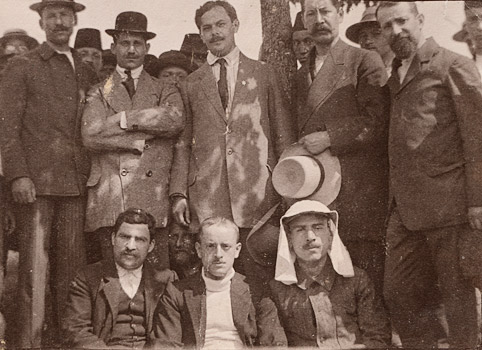
"Maccabi Group excursion - Constantinople, 1916". Haim, bearded, stands on the far right.
According to Haim's notes in the Jabotinsky Archives, this was taken in the Jewish colony (moshava) Mesila Hadasha in Constantinople.
(Collection of the author)

"Jewish Sport group excursion - Constantinople, 1916". Haim, with a beard, is second from the right in the middle row.
Jewish colony (moshava) Mesila Hadasha in Constantinople.
(Collection of the author)
I had long assumed the date was wrong, believing that Maccabi had ceased operations at the start of WWI. However, it appears that the main Pera branch continued to operate during the war.
Two articles in Hamenora, the publication of the B'nai B'rith lodge, mention outdoors activities occuring after the outbreak of the war, making the 1916 date credible. One, dating from July-August 1924 states:
"[...] Until the Great War our work was limited to so-called indoor gymnastics - apparatus and group movements. [...] Outdoor sport was gaining ground everywhere and imposing new guidelines on us."
"Already, during the war, we made the attempt at scouting. Our numerous, well equipped, excellently trained 'Drorim' were, for years, our pride. [...] we added [...] the practice of outdoor sports, athletics in its most modern expression."
"Our football section, already existing before the war, saw its ranks grow and the Macecabi selection managed to rank first in the Constantinopolitan tournament called "Sundays", for the 1921-1922 season. "
Another article in the February 1925 issue of the same publication implies that soccer and scoutism both started after the beginning of WW1:
"The cataclysm of the World War was soon to paralyze this beautiful activity. [...] Other technical branches were soon to be added to apparatus gymnastics: I mean the "Sénif Kadour Réguel" or Football as well as the Drorim or Scouts Section.
Another reason I assumed the photos were taken before 1914 is that Haim appears with a beard, but he was said to have shaved it after his marriage that spring. Additionally, Sarah Aaronsohn wrote in August 1916 that he had been in Germany for "almost two years." However, it's possible that Haim returned to Constantinople after Sarah left (and grew his beard back).
The last mention of Haim's role with Maccabi appears in the February 1925 issue of Hamenora, the monthly publication of B'nai B'rith, Oriental District XI. The speech given on the occasion of the 30th anniversary of the Jewish sports association of Constantinople is reproduced in the magazine and ends with a mention about the four "vailant pioneers" of the organisation. It's not clear however if Haim still took an active part in the group by then.
"[...] I am honored to thank our valiant pioneers: MM. M. ABRAMOWITZ, HAYM AVRAHAM, ALBERT ZIFFER and JACQUES M. BARZILAI for the long years of labor devoted to our work. Your names and your memory are forever etched in letters of gold in the annals of the Maccabi.
Zionism
In her memoirs, Sarah Eldar recalled that
"[Haim] had very good relations with many Zionist leaders of Germany and Eastern Europe, and the Palestinian Rahel Yanait-Ben Zvi, Hana Maizel. On the other hand he had criticism for the behaviour and habits of the Yishuv leaders, although he admired Haim Arlozorof [...]. He also liked Vladimir (Ze'ev) Jabotinsky, and was against David Ben Gurion.
What is fascinating is that the people listed here belonged to the entire spectrum of Zionist tendencies, from Marxist and Socialist to right-wing revisionism. One must conclude that, above all, Haim's focus was on Zionist activism, without much concern for any other underlying considerations. What all these names seem to have in common is the rejection of the so-called territorialist option, along with a focus on direct activism. Also to be noted is the presence of a couple of feminist women, in stark contrast to his future portrayal as a backward "Oriental" man.
- Haim Arlozorof was a Socialist Zionist leader of the Yishuv who would later be assassinated, most likely by an extreme-right Jew.
- Ze'ev Jabotinsky, at the other end of the political spectrum, was the leader of the right-wing Revisionist Zionists. He would establish Betar and the Irgun and would be an inspiration for Menahem Begin
- Rahel Yanait-Ben Zvi was a labor (left-wing) activist who founded "The Educational Farm" in Jerusalem, a farm that provided agricultural education for women. Active in the Haganah paramilitary organization, she also organized the clandestine aliyah of immigrants through Syria and Lebanon. She was the wife of the second President of Israel, Yitzhak Ben-Zvi.
- Hana Maizel, another woman, was a a noted agronomist, a founder of Havat HaAlamot, a women's agricultural training program at Kibbutz Kinneret in 1911, and of the agricultural school for girls at Nahalal. A member of Poale Zion (a Marxist-Zionist Jewish workers movement), she made a considerable contributions to the feminist wing of the Zionist movement. She would later be elected to the Assembly of Representatives.
I assume that Haim got to know many of these Zionist leaders through his activities with Maccabi, as Zionist leaders often attended Maccabi congresses and demonstrations.
For example, David Rimon writes:
"In October 1908, a national society of Turkish Jews called "Achava" (אחוה) was founded by the Zionists in Constantinople. The Israeli Gymnastics Association joined this society. At the founding meeting of the Achava, Jabotinsky delivered an enthusiastic Zionist speech."
Rimon also mentions that, at the end of 1908, when Haim and Moritz had already joined the leadership of Maccabi in Constantinople,:
"[...] more than a hundred members of [Maccabi Bulgaria] went on a propaganda trip to [...] Constantinople in Turkey. [...] During their visit to Constantinople, members of Maccabi Bulgaria were invited by the Turkish authorities to participate in a celebratory military parade. One of the gymnastics performances of Maccabi-Bulgaria members was held in honor of the leaders of the Zionist movement, David Wolfson, Nahum Sokolov and Menachem Ussishkin, who were in Constantinople at the time on an important political mission."
In her memoirs, Sarah Eldar recalled that Haim attended, "if not as a delegate, as a spectator" some of the Zionist Congresses. Indeed, Haim's name doesn't appear on the lists of delegates for any of the Congresses. However, his participation may have been more involved than just a spectator, considering that Maccabi took part in (at least some of) the congresses.
In September 1913, Haim attended the 11th Zionist Congress in Vienna, during which 1,450 gymnasts participated in a mass display of Jewish Gymnasts. According to Haim's notes accompanying the photo below, "From Kushta the representatives were Abramowitz and H. Abraham". I assume this means they represented the Constantinople Maccabi for the gymnastics events, and not as congress representatives, as Haim's name doesn't appear on the official list of representatives.
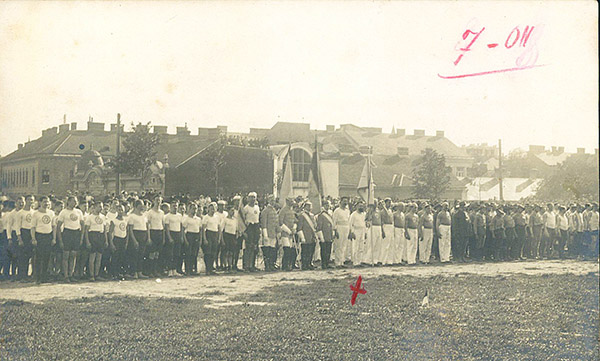
At the sport event of all Maccabi organizations of Europe during the 11th Zionist Congress in Vienna, 1913.
Haim is in the center, above the "X" mark.
Source: Jabotinsky Archives
He sent a commemorative card to "Rivka", his sister-in-law, in Hebrew.

Postcard from Vienna - Sept 4, 1913.
(Collection of the author)

Postcard from Vienna addressed to Riwka Abraham - Sept 4, 1913.
(Collection of the author)
As reported in the Jewish weekly L'Aurore, Haim gave a speech in celebration of Eliezer Ben Yehuda's 50th* birthday in October 1910. Ben Yehuda led the revival of Hebrew as a modern, spoken language. (*Ben Yehuda was born in 1858, so the 50th birthday was off by two years).
Haim's company, Abraham Freres, appears on a list of donors to the Jewish National Fund for 1908 and 1910. Although the donations appear small, they are notable for being the only ones from Constantinople in 1908.
B'nai B'rith
Haim mentioned in the annotated list of photos kept in the Jabotinsky Archive that he was one of the founders of the B'nai B'rith Lodge in Constantinople, which was established at the end of 1911. On March 28, 1912, he was initiated in the B'nai B'rith Grand Lodge District XI.

Bulletin de la Grande Loge de district XI et de la Loge de Constantinople no. 678, ca. 1912
Source: archives.saltresearch.org, via Cenker Sarıkaya.
Along with Haim and Moritz Abraham, the list includes Dr. Israel Auerbach, M. Abramovitz, and J. Barzilaï from Maccabi.
The Jewish fraternal organization promoted mutual aid, philanthropy, community service, and the defense of Jewish rights, and represented a progressive, Western-oriented identity within the local Jewish community.

"Notables of the Jewish Community in Constantinople", date unknown. Haim, bearded, standing on the far right.
Note the button on the lapel of Haim's jacket, also worn by three other men - maybe a B'nai B'rith pin?
(Collection of the author)
Palestine
Haim travelled to Palestine in the Spring of 1913, as evidenced by two postcards sent to Ronya ("Rivka"), one mailed from Jerusalem, the other from Jaffa.
The reasons for this trip are not known, whether business-related, or connected to his Zionist activities. It is probable that he met his future wife Sarah Aaronsohn at that time.
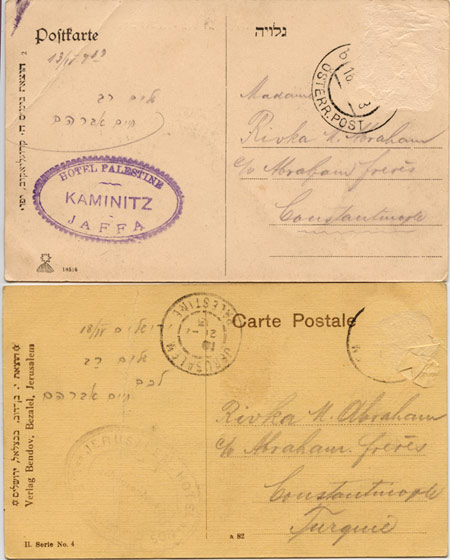
Two postcards from Haim Abraham to Ronya Datnowsky, 1913.
(Collection of the author)
Both postcards are very brief: "Shalom Rav (lachem), Haim Abraham" - "Many Blessings (to you), Haim Abraham." Note that the address is simply "Abraham Freres, Constantinople." It's not clear why he addressed these postcards to his sister-in-law and not to his brother.
As already noted, in September 1913, Haim was in Vienna and attended the XI Zionist Congress.
Marriage to Sarah Aaronsohn
If Haim is remembered outside of his family, it is for having wed Sarah Aaronsohn, the NILI spy, the "Jewish Joan of Arc".
According to Sarah Cohen Eldar's testimony, Haim was introduced to Sarah Aaronson through Dr. Israel Auerbach who was a friend of the Aaronson family. Auerbach - a prominent member of the Jewish community in Berlin and Constantinople - was the brother-in-law of Ronya who was married to one of Haim's brothers - Moritz.
(Haim Abraham and Israel Auerbach had probably met in 1908 when they both arrived in Constantinople and joined the management of the Maccabi association.)
It is also possible that Haim had already heard about the Aaronsohn family through his sister-in-law (and my grandmother) Ronya, who had visited the Aaronsohns in Zichron Yaakov in 1910/1911.
According to Israel Auerbach, Haim had said he wanted "a girl from one of the real pioneers" that had settled Palestine.
According to the official Aaronsohn lore, Sarah had agreed to the union without even meeting Haim. However, we don't know Haim's version, and it is clear that the oft-repeated "official" version, being one-sided, is probably not the entire story.
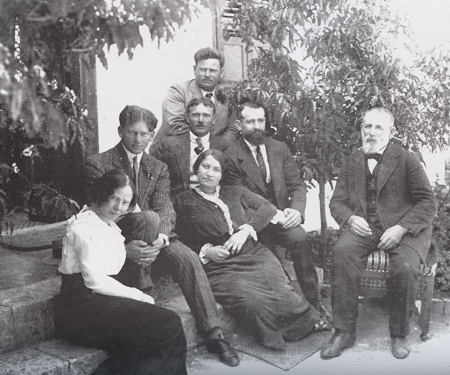
The Aaronsohn family with Haim Abraham in Zichron Yaakov.
Haim Abraham and Sarah Aaronsohn were married on the grounds of the Athlit station, under a velvet canopy on March 31st, 1914 (4 Nissan 5674). Haim was thirty-five years old, Sarah twenty-four.
Sarah Cohen Eldar: "They [Haim and Miriam] used to say that [Haim] financed Sarah's dowry."
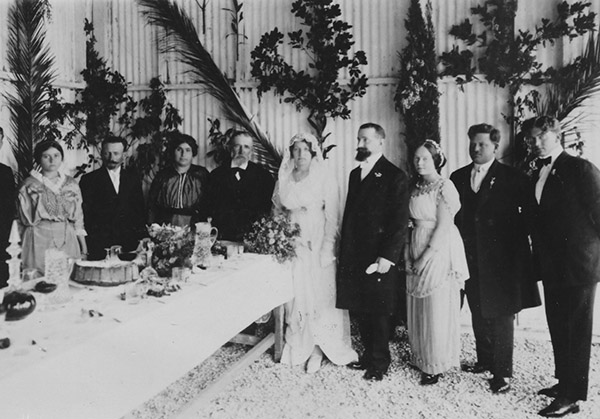
Sarah Aaronsohn and Haim Abraham wedding party, March 1914.
From right to left: Alexander, Aharon, Rivka, Haim Abraham, Sara (in a wedding dress), Fishel, Malka, unidentified, Rivka Lishansky, Yosef Lishansky.

Wedding announcement, Hapoel Hatzair. April 6, 1914.
(Photo source: Historical Jewish Press)

Wedding announcement.
(Collection of the author)
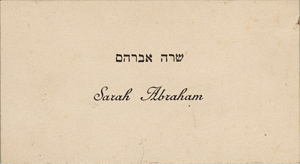
Sarah Abraham.
(Collection of the author)
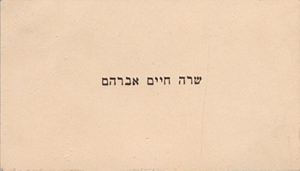
Sarah Haim Abraham.
(Collection of the author)
After their wedding, Haim and Sarah traveled to Haifa, where they boarded a ship to Constantinople.
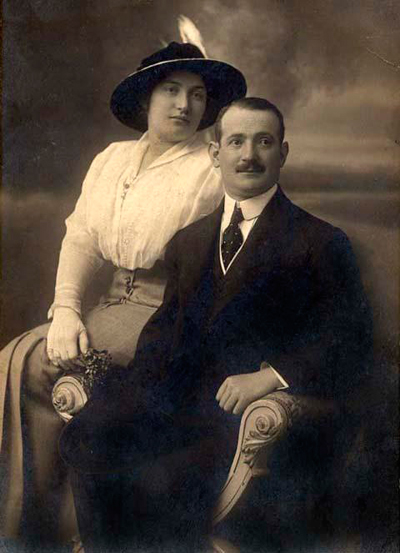
Sarah Aaronsohn and Haim as young married couple, Constantinople.
Photo: Sebah & Joaillier
(Photo courtesy of Sarah Cohen Eldar)
In Constantinople, the couple posed for a formal portrait at the Sebah & Joaillier studio, where members of the Abraham and Datnowsky families had their photos taken over the years. Now beardless, Haim is hardly recognizable, and bears a striking resemblance with his brother Moritz.
WW1
On 28 July 1914, four months after their wedding, World War 1 started. At first, the conflict must have seemed distant from Constantinople.
A letter from Sabetai Levy from the "Bureau de la Jewish Colonisation Association" in Haifa dated September 2nd, 1914, indicates that Haim was interested in buying a plot of land in Palestine:
Dear Mr. Abraham!
[...] I will gladly look into the question of the purchase of land at Hedera on your behalf on advantageous terms and I will not fail to talk to Mr. A. Aaronsohn as soon as I have found a good [?].
I hope that until the next letter, peace will already reign in Europe and we will be able to tell you in detail the unpleasant moments that we are still having despite not being at war.
Sabetai Levy: Born in Constantinople and trained as a lawyer, he made Aliyah in 1894. Employed as a clerk for the Baron Edmond James de Rothschild for the Zichron Yaacov administration, he later moved to Haifa and managed the law and land departments of the PJCA and Jewish Colonization Association, and was the Hilfsverein representative for Palestine. He would become Haifa's first Jewish mayor in 1941.
Acting on behalf of the "Jüdisches Institut für Technische Errichtung in Palästina", he exchanged letters and cables with Ascher Mallah in 1911-1912 regarding the establishment of the Technion in Haifa.
One month later, on October 2, 1914, another letter from Sabetai Levy, mentions with more details the possibility of Haim purchasing land in Hadera:
Dear Mr. Abraham!
We recently discussed with Mr. Aaronsohn about the proposal he made to you for the purchase of an income property in Hedera with a plot of land that you can plant little by little. It is true that you will have to disburse a large sum immediately, but it is an investment that will return 6 to 6 1/2% even in the year of purchase, guaranteed.
I think it would be good to enter into talks with the seller, but to conclude only after the situation [the war] will improve; only it should be noted that until then the owner will benefit from this year's harvest and will leave you a plantation which will require high maintenance costs until the next harvest.
Before concluding, I will be pleased to reassure you, as well as Mrs. Abraham [Sarah Aaronsohn], that neither our colonies nor ourselves in town have in any way been tested by the situation, and hope that we will not be, until the situation returns to normal. The financial situation is very critical, but it is general.
Married Life
The couple lived in Haim's apartment in Galata, a neighborhood in the European half of Constantinople.
The marriage wasn't happy and wouldn't last - one even wonders why Sarah even decided to wed a man she did not know well, if at all, and with whom she was apparently not in love. The explanation usually offered by authors is that she felt obligated to get married so her younger sister Rivka could marry the man they both loved, Avshalom Feinberg.
The reality may be a little less simplistic. It seems that Sarah was an impulsive person who could make irrational choices; she may also have found the idea of marrying a wealthy businessman attractive.
However, the life she found in Constantinople didn't match her expectations, and it soon became clear to her that she and Haim were not meant to be together. She became homesick, if not downright depressed, as attested by her letters from the summer of 1915.
She also began to worry about her family who was suffering under the Turkish rule. But probably the main reason for her change of heart was learning that Avshalom Feinberg had not married her sister Rivka after all. Rather, she had gone to America, and Avshalom now wrote to Sarah that she was the one he wanted.
In the second half of August 1915, while Haim was away on a business trip to Germany and Vienna, Sarah started making arrangements to leave Constantinople and to return to her family in Zichron. She finally left on November 25, 1915, officially voicing her intention to return to Constantinople after a few months.
After returning to Zichron, Sarah wrote letters to Haim promising to come back after a few months. She asked him for money, saying she would be back for the Passover, or after she'd finished helping her family. Whether she had originally intended to come back after a few months, then changed her mind after meeting Avshalom Feinberg again, or whether she had run away with no intention of ever coming back, is not clear. It seems, however, that Haim expected at first that she would return.
Sarah, of course, joined her brother's NILI spy organization to which she now devoted her life. There are no indications that Haim was ever aware of her involvement or of the existence of NILI.
As the separation dragged on, he may have slowly realized that this wouldn't be the case after all. He must have been feeling disenchanted, and may have felt used: he apparently resisted Sarah's requests for money. At some point he considered selling the land that he had received as part of her dowry. He probably had concluded by then that there was no point in coming to Zichron if their relationship was obsolete.
At the same time, Aaron Aaronsohn continued to be close with Haim. Although he was upset about Sarah's unhappy marriage - for which Haim was universally blamed in the Aronsohn camp - he continued to correspond with Haim, acting as if nothing was wrong.
It is more than likely that this was an interested decision on Aaron's part. He reached out to Haim when he needed to borrow money; he probably took advantage of Haim's ability to send letters between Germany and Turkey during the war to relay his own messages. He may also have gathered bits of information through conversations with Haim and his brothers Moritz and Mony, as they all had a large number of contacts with the industrial, political and diplomatic world.
(See a sample of calling cards from Haim's brother Moritz.)
Even Avshalom Feinberg, despite his awkward position, did not hesitate to contact Haim when he needed help. Once again, it is not clear how aware Haim was, if at all, of Avshalom's role in Sarah's running away, and whether Haim ever felt he was being used.
With the teasing words from both Avshalom and Aaron included in a letter from Sarah (January 23rd, 1916), Haim would have had to be blind to not understand or guess what was going on:
Aussitot échappée elle n'a fait qu'un bond
Et je vous jure: vous ne la verrez plus de longtemps
Le ciel hivernal est redevenu clair et blond
Merci à Constantinople de cet extra-Printemps
A.F.Ceci veut dire qu'on te permettra de venir la voir - et encore, c'est-à-dire si tu es bien gentil. Mais quant à te t'envoyer (sic) Sarati, tu ne dois plus y compter: on l'aime bien trop ici.
Absalom qui est la bonté personnifiée m'a reproché de t'avoir dit ce qui est ci-dessus de peur que tu ne maigrisses et deviennes encore plus rouge.
A.
As soon as she had escaped, she made just one leap
And I swear to you: you shall not see her again for a long time
The wintery sky has turned clear and blond again
Thank you to Constantinople for this extra Spring
A.F. [Avshalom Feinberg]This means that we will allow you to come see her - and again, that is, if you are nice. But as for sending you our Sarati [Sarah] back, you must not count on it anymore: we like her too much here.
Avshalom, who is goodness personified, has blamed me for telling you the above, out of fear that you shall lose weight and become even redder.
A. [Aaron Aronsohn]
At the same time, it is unlikely that he was aware of Aaron's real activities at that point, so the question remains why Haim continued to be on friendly terms with the Aaronsohns and to offer his help when asked.
Haim also sent money [1000 German marks, equivalent to about $4000 in 2009] to help the Jewish community in Palestine suffering from the Turkish repression during the war.
This gift was mentioned in a letter from Sarah to her brother Aaron (August 23 1916), but instead of showing some appreciation for the gift, she displayed scorn.
"What do you say of his generosity? How it amused me. If the poor man knew how many thousands of pounds pass through my hands, and how many thousands of francs I spend, what would he say?"
Because of the war raging in Europe, it had become too difficult for Haim to run his business from Turkey, and he had temporarily relocated in Germany where he would spend a couple of years.
Based on correspondance between Haim and Aron Aaronsohn, Haim was apparently based for a while out of a hotel in Elberfeld, Germany. Haim's letter to Aaronsohn dated October 5 1916 included the following stamp:
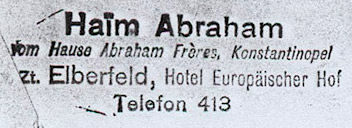
Haim Abraham Stamp, Elberfeld, 1916.
Haim Abraham
From Hause Abraham Frères, Konstantinopel
Elberfeld, Hotel Europaisher Hof
The fact that Haim had a stamp made mentioning "Abraham Frères" with the hotel name suggests that he probably had a long-term arrangement there. Probably not incidently, Elberfeld was the location of at least one of Abraham Freres suppliers, Paulmann & Kellermann.
According to a letter from Sarah, Haim was in Germany for almost two years, and moved to Hagen, Westphalia (Germany), from where it was easier to communicate and conduct business with Constantinople. (Note: Hagen, and not The Hague in the Netherlands, as stated incorrectly by all authors.)
Haim was in Hagen, Westphalia (Germany), as evidenced by surviving correspondance sent by Haim to Abraham Freres in 1917. Abraham Freres did business with a number of companies based in Hagen (Lersch & Kruse, H Münzing Spedition), so just like with Elberfeld, it seems that Haim based himself close to his suppliers.
In a letter to her brother Aaron, Sarah says that Haim
"(he) has lost a lot of weight in the latest German fashion. He works hard and suffers from our being separated. He tells me how much he would like us to meet again."
Sarah was eventually captured and tortured by the Turks, commiting suicide in October 1917.
1920's - 1930's
This photo kept in the Jabotinsky Archives comes with the following surprising description by Haim: "My picture from 1922 on my return to Constantinople, after the end of World War". If meant to be taken literally, this would indicate that Haim remained in Germany for another four years after the end of WW1.
If so, this would mean that Moritz and Haim split responsibilities between them: from Constantinople, Moritz would have run the business and connected with buyers, while Haim would have been responsible for working with the various manufacturers in Germany and neighboring countries. This arrangement probably made sense based on their respective family situations: Moritz, with a family with two children could remain home, whereas Haim, being single, could more easily be away.
According to the 1921 and 1922 editions of the Annuaire Oriental, Haim address in Constantinople was Impasse Macri, off the Luledji Hendek street, in Galata.

Annuaire Oriental 1921
(Although this could be the ground floor apartment where Haim lived at the time of his marriage with Sarah Aaronsohn in 1914-1915, it's impossible to know for sure. Haim's address is not listed in the 1913 and 1914 editions of the Annuaire Oriental, and both issues list another tenant for that apartment.)
(The Casaretto building still stands today. According to a 2016 tourist guide, Lüleci Hendek Street is now "one of the trendiest streets in Galata with new stores, boutiques, and cafés. One of the oldest buildings in the neighborhood is a 1907-dated Art Nouveau building called the Papadopoulos Brothers Apartment. The other historic apartments in the street include Mimicopoulo, Capozzi, and Casaretto apartments.)
If Haim indeed only came back from Germany in 1922, it is not clear what caused his return. Maybe Moritz's plans to move to Düsseldorf (he had bought a plot of land there in 1922) meant that their roles would be reversed: Haim would now run the business from Constantinople, while Moritz would handle the suppliers from his base in Germany. Maybe these changes sowed the seeds of their breakup. At the end of 1922, a violent dispute arose between Haim and his brother Moritz, and the Abraham Freres partnership was dissolved.
Little is known about Haim's life during the following decade. He continued to do business between Germany and Turkey, now operating on his own.
On September 12, 1924 (13 Elul 5684), Haim remarried in Constantinople, to Miriam Franco.
Miriam was born in Constantinople in August 1889, the daughter of Albert. On the couple's 1939 application for citizenship in Palestine, her nationality prior to her marriage was listed as Italian.
The February 1925 issue of Hamenora, the monthly publication of the B'nai B'rith, mentions "Haym Avraham and Mrs. Haym Avraham" as guests of a banquet celebrating the 30th anniversary of Maccabi.
Haim received a "Certificate of Good Conduct" on July 19, 1928. Surprisingly, his place of birth was recorded as Athens, not Ruse.
Two months later, his name ("Haim Abram Yacob") was added to the 1928-1930 registry book of the Spanish Consulate in Constantinople, suggesting that he was either under the protection of the Spanish Consulate, or held a Spanish passport by then.
| Registry Book 1928-1930 | ||||||
|---|---|---|---|---|---|---|
| Family Name | Given Name | Name of Parents | Date of Birth | Place of Birth | Profession | Registry Date |
| Abram Yacob | Hayim | Mamo and Lea | 10 May 1879 | Athens | Merchant, Seh Davut h. in Tahtakale | 18 Sept 1928 |
Again, his place of birth was listed as Athens instead of Rustshuk. How or why this happened—whether the result of a clerical error, or an intentional obfuscation on his part—is unclear.
His business at that time was located in Seyh Davud Han, Tahtakale street. (Alternate spellings: Tahta Kalé, Tahta-Kalé.)
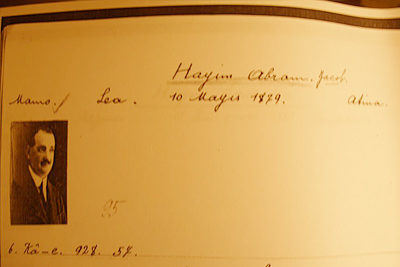
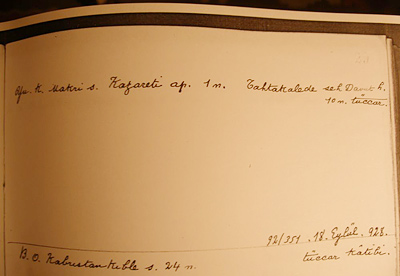
Spanish Consulate Register 1929.
(Photo courtesy of Pablo Martín Asuero)
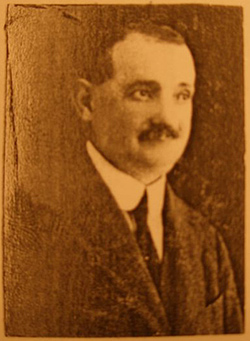
Haim, ca 1928.
(Photo courtesy of Pablo Martín Asuero)
The 1931 B'nai B'rith Lodge membership list confirms his addresses at the time:

Loge de Constantinople, no. 678, Guide. J. Castro, 1931.
Courtesy of Cenker Sarıkaya
Brother Haim Abraham
Initiation Date: March 28, 1912
Profession: Commissionnaire
Residence: Pera, Makri Kazaretto street, Han N. 1
Office: Istanbul, Tahtakalé Cheh, Davout Han N. 13
By the time of his brother Isak's death in December 1931, Haim's business was still located at the same address: Seyh Davud Han, Tahtakale street ("Tahtakale Cheich Daou'd Han.")
Israel
Haim and Miriam immigrated to Palestine on August 31st, 1932. They lived at 60, Rehov HaAliah (רחוב העליה) in Bat Galim, a wealthy Haifa neighborhood with Bauhaus-designed private homes. There, Haim continued to to run an import business between Germany and Turkey, under the name "House Abraham".
Sarah Cohen Eldar: "He continued his commerce, importing meat from Turkey (?)".
"In Haifa, Haim remained active in the Bulgarian-Turkish Community. He also tried to preserve the Rustchuk traditions of prayers and way of life. In typical German tradition, he also spent time in coffee houses and befriended Polish and German Jews."
Haim and Miriam's Application for Palestinian citizenship in July 1939 provides a few additional details.
Haim had taken four trips out of Palestine in 1937, with three almost month-long absences in July, August and September, for a total of 80 days during the year. I assume these were business trips during which he visit European suppliers. No more exit visas were recorded after September 1937, maybe a sign that he stopped or at least slowed down his commercial activities around 1938.
One of the documents attached to his file asks for clarification: "[...] whether the applicant is a Spanish citizen or a Spanish protected person". The answer attached to the document states that "According to his Spanish passport he is described as a National of Spain. He declares that he is a Spanish citizen."
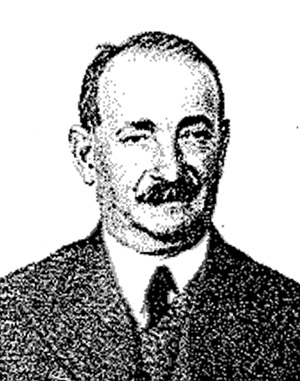
Haim Abraham, 1939
(Photo source: Citizenship application)
According to Ran Aaronsohn, Aron Aaronsohn's grand-nephew, Haim remained in contact with the Aaronsohn family, visiting the widow of Schmuel Aaronsohn (Aaron's youngest brother) in the early 1950's.
Ran Aaronsohn: "Haim used to visit my grandma Miriam, Shmuel's widow, in Haifa, where [my parents] met him and his second wife between 1950 and 1953. They remember that they were impressed by his good manners and kindness. [...] My grandpa passed away in spring 1950."
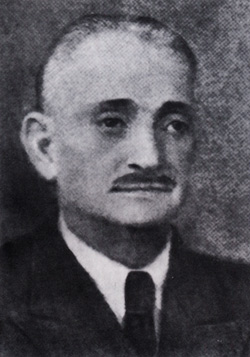
Haim Abraham
(Photo source: "The Bulgarians from Haifa")
Aside from his house in Bat Galim, Haim and his wife Miriam owned a plot of land located on 8, Bialik Street. The British oil company Shell made a generous offer to purchase the lot, but his answer was "I refuse to sell this property to strangers!" He was then approached by the leaders of the Bulgarian Community who convinced him to donate the property for a synagogue. Upon his approval, they established the "Association of the Trustees of Beit Haim Abraham" ("Agudat Ne'emanei Beit Haim Abraham") in August 1945. The association, however, struggled to raise sufficient money to build the synagogue, causing delays to the actual construction.
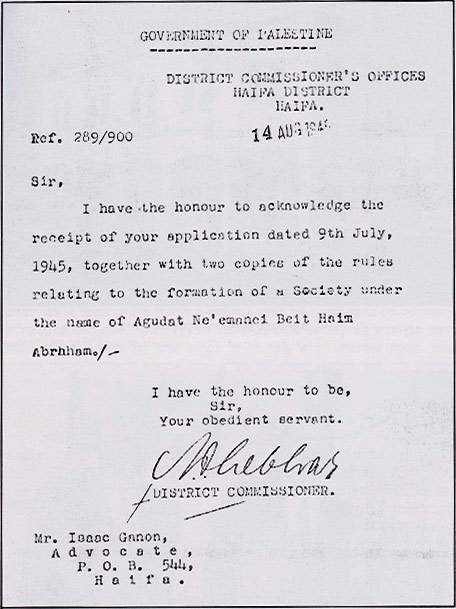
(Photo source: "The Bulgarians from Haifa")
Haim died on January 17, 1954 (Shvat 13 5714), and never saw the conclusion of the construction of the building. In his will, Haim donated all his money to various charities in Haifa and to Beit Haim Abraham.
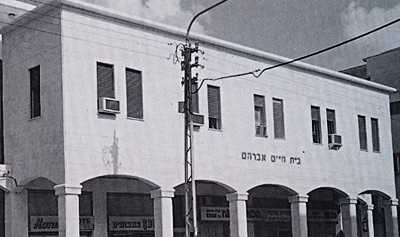
Beit Haim Abraham, Haifa. The Community Center for Bulgarian immigrants in Haifa, named after Haim.
(Photo source: "The Bulgarians from Haifa")
His wife Miriam died on December 12, 1958 (Tevet 1 5719).
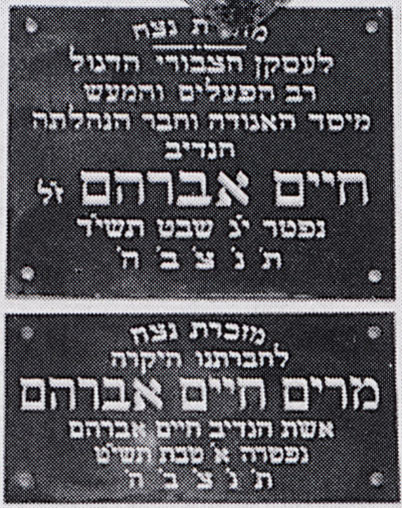
Memorial plaques in the Beit Haim Abraham Synagogue
(Photo source: "The Bulgarians from Haifa")
In Everlasting Memory
To the Great Activist
Of Great Deeds and Actions
Generous Founder and Manager of the Association
Haim Avraham of Blessed Memory
Died on Shvat 13 5714
In Everlasting Memory
To Our Dear Miriam Haim Abraham
Wife of the Generous Haim Abraham
Died on Tevet 1 5719
- Special Thanks:
- Sarah Cohen Eldar, Iris and Yaakov Nir, for making her journal available, answering my many questions and providing photos.
- Dr. Gilad Rosenberg, for additional information, photos and translations, and for the copy of David Rimon's book "HaMaccabi Be'Artzot HaBalkan".
- Michael Rosenberg, for the copy of the book "The Bulgarians from Haifa".
- Beit Aaronsohn, for access to the Aaronsohn/Abraham correspondence.
- Ran Aaronsohn, for sharing his family's recollections of Haim Abraham.
- Pablo Martín Asuero, for providing me with copies of the 1928-1930 Registry of the Spanish Consulate in Constantinople.
- Rony Dror, from the Yosef Yekutieli Maccabi Sports Archive.
- Olga Gechman, for graciously sharing photos of Haim Abraham preserved in the Jabotinsky Archives.
- Cenker Sarıkaya, for his invaluable help and for uncovering artifacts related to the Abraham brothers in Istanbul.
- Links:
- Haim Abraham letters about personal and business matters, 29.11.1906 - 17.11.1916: Jabotinsky Institute In Israel Archives
- Haim Abraham personal documents and autobiographical notes, 23.06.1898 - 09.01.1932: Jabotinsky Institute In Israel Archives
- References and Publications:
- Memoirs. Unpublished.
- Jüdische Turnbewegung - Jewish German Gymnastics System in Turkey until 1918" (pdf - link). Journal of Human Sciences, Vol 6, No 2 (2009)
- . "HaMaccabi Be'Artzot HaBalkan" (The Maccabi in Balkan States). 1945
-
.
הדגל הציוני מעל הבוספורוס. ה"מכבי" בקושטא בין ציונות לעותמניות 1923-1895.
עמותת יוצאי התנועה הציונית בטורקיה
The Zionist flag above the Bosphorus. "Maccabi" in Constantinople between Zionism and the Ottoman Empire, 1923-1895. Association of Veterans of the Zionist Movement in Turkey, Jerusalem - . Maccabi Bulgaria. Committee in honor of Albert Kioso, 1976
- . Jüdische Turnzeitung 1900-1921. Neuhrsg. (1977). Walluf/Neudeln. Sändig
- . "Zionism, Nationalism and the Emergence of the Jüdische Turnerschaft". Leo Baeck Institute Yearbook - 1983.
- The Bulgarians from Haifa. Association of Beit Haim Abraham Trustees. 1998.
- Diary (Yoman Aaron Aaronsohn: 1916-1919, Tel Aviv. Karni. 1970) Beit Aaronsohn (French).
- . "El Consulado de España y la Protección de los Sefardíes entre 1804 y 1930". Editorial Isis Estambul - 2011.
- The Nili Spies. Hogarth Press, London, 1959.
- The Gideonites. Funk and Wagnalls. New York, 1968.
- A Spy for Freedom. E. P. Dutton & Co., Lodestar, 1984.
- The Aaronsohn Saga. Gefen Publishing House Ltd, 2007 (original Hebrew version: 2000).
- A Strange Death. Public Affairs, 2005.
- Lawrence and Aaronsohn. Penguin, 2007.
- Aaronsohn's Maps. Harcourt, 2007.
- Additional Sources:
- Jewish Education in Southeastern Europe (Mid 19th-Mid 20th Century) (pdf).
- Les Juifs espagnols en Bulgarie .
- archives.saltresearch.org (Annuaire Oriental, 1921)
